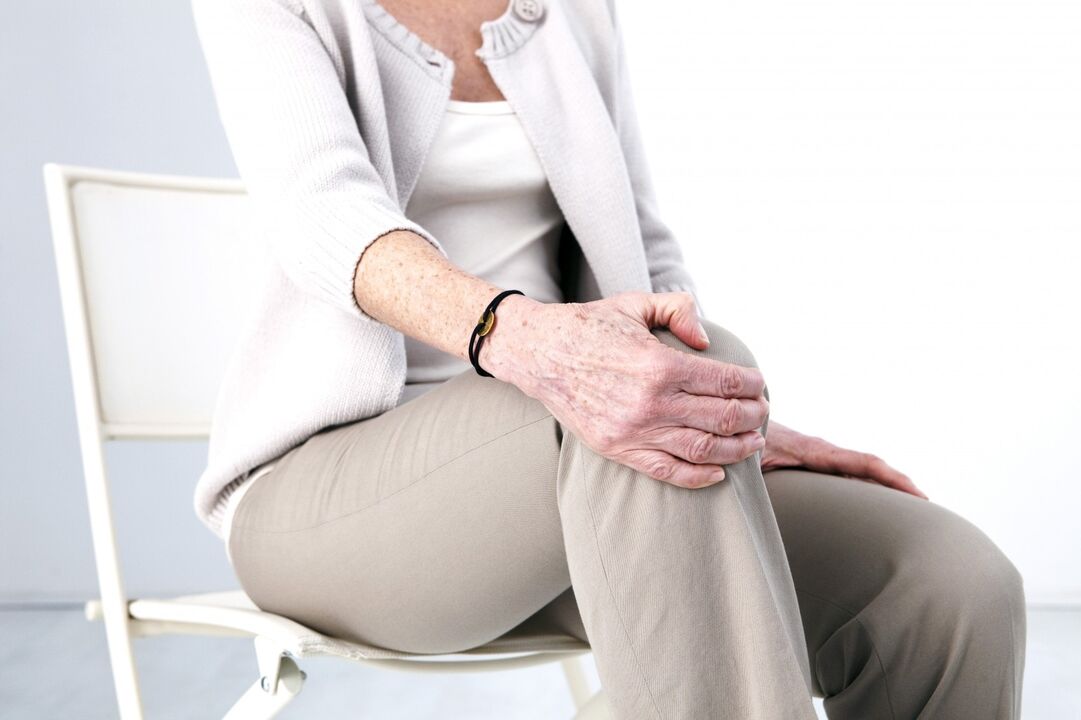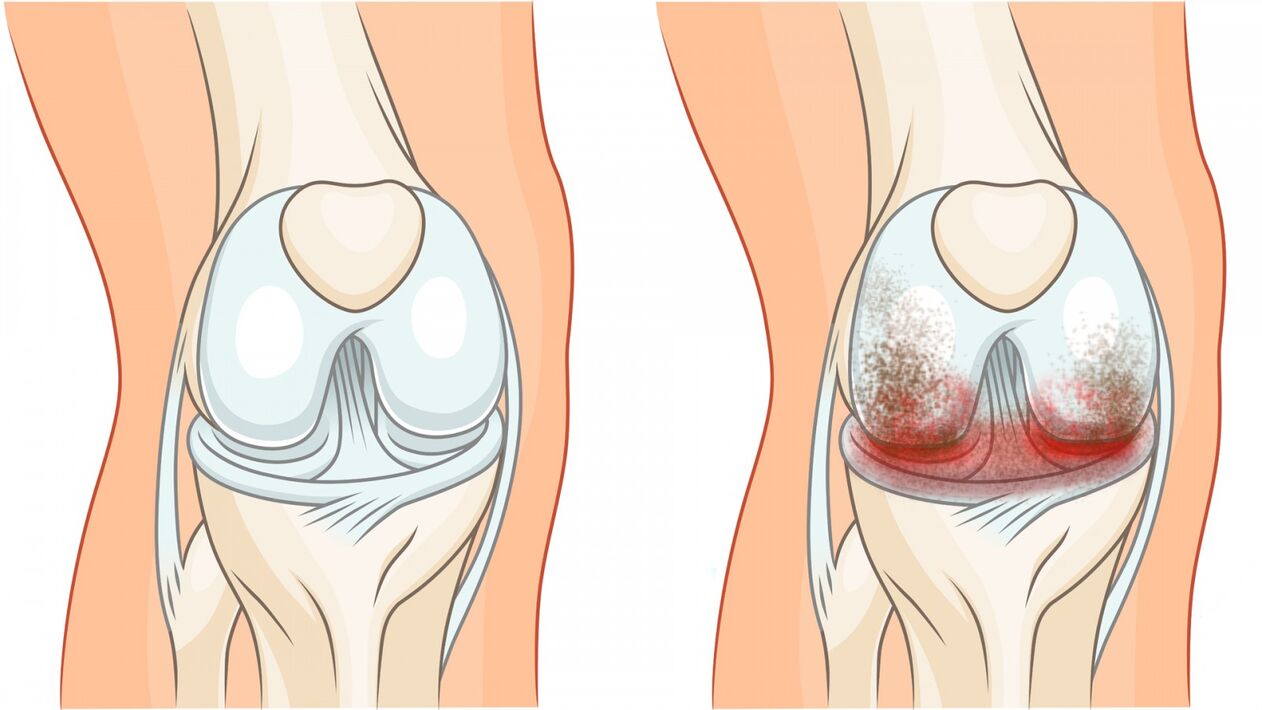Knee pain is a common complaint to see a doctor. What is the cause of the pain, and if so, how can you help yourself? There is no definitive answer, because the knee joints can suffer from various types of lesions for many reasons. One of these causes (and very common) is primary osteoarthritis. Today we will give you detailed information about osteoarthritis of the knee joint: what are the causes, types, symptoms and signs, methods of treatment and prevention.
Types and causes of the disease
Osteoarthritis or gonarthrosis of the knee joint is a mostly non-inflammatory lesion that results in the destruction of joint cartilage, deformity of the knee, and limited range of motion. There are two main forms of the disease:
- primary - arises from a congenital joint defect;
- secondary - occurs as a result of other diseases or injuries.
The initial form begins to develop in childhood or at a young age and is caused by improper formation of articular surfaces or garden apparatus. While traveling, such a combination is subjected to a load that is not proportional to its capabilities, which leads to degenerative changes.
The development of a secondary pathological form can lead to the following:
- Injuries: fractures of the bones of the legs, bruises and dislocations of the knee, accompanied by damage to the bone and cartilage parts of the joint and the ligament apparatus. In this condition, post-traumatic osteoarthritis of the knee joint develops.
- Removal of the meniscus causes disruption of the integral structure of the knee and rapid wear.
- Athletes often have a higher load than the legs they are exposed to.
- Excessive obesity also causes osteoarthritis because it puts too much weight on the articular cartilage of the knee.
- Arthritis is an inflammation of the joints. Long-term arthritis is accompanied by the formation of fluid in the joint cavity and over time can be complicated by osteoarthritis.
- Metabolic diseases that cause the deposition of salts in the articular cavities.
- Other factors and diseases accompanied by prolonged spasm of the muscles of the legs or blood vessels.
- Transferred operations.
The pathological process can be unilateral or bilateral. As a result of trauma, unilateral osteoarthritis (eg, right knee) and bilateral development without obesity are more likely.

Typical symptoms
Osteoarthritis of the knee joint develops gradually, sometimes in the absence of initial symptoms (such as severe pain and visible deformity), but from time to time there is a feeling of discomfort, the months and years of the initial period come. knees.
Often, overweight women over the age of 40 get sick and are one of the aggravating factors, especially those suffering from varicose veins.
The development of gonarthrosis goes through several stages:
- The initial stage can last for months and sometimes years. Knee pain is a concern, especially when a person takes the first steps after getting out of bed in the morning, as well as when climbing stairs.
- In the second stage, the pain intensifies and occurs with any movement accompanied by a characteristic crisis. Fluid accumulation is possible in the articular cavity, and you can see the newly formed deformation during the examination. The range of motion in a painful knee begins to decrease.
- The third stage is characterized by pain that does not go away at rest. There is more anxiety before the weather changes. By this time, the joints have lost much of their function: the legs hardly bend at the knees or bend to the end. Walking changes: "swings" or occurs on bent legs. The deformation of the knees is very obvious: the legs are bent and take the form of O or X.
Symptoms of post-traumatic osteoarthritis of the knee joint develop more rapidly. Pain and swelling in the knee area appear on the background of the injury. This kind of pain always accompanies a person and increases after physical exertion. Gradually, a feeling of tightness and stiffness in the knee joins him. Sometimes with this form of the disease, it takes only a few months from the initial symptoms to irreversible changes.

Treatment of gonarthrosis
The scope of treatment depends on the stage of the disease and the severity of the lesion. However, since the disease is chronic, the only thing that can be achieved is long-term remission (rest periods are minimal or absent). At the same time, if it is possible to eliminate the cause of osteoarthritis of the knee joint in the early stages (for example, to reduce body weight), almost complete recovery is possible.
Objectives of treatment of gonarthrosis:
- relieve pain,
- if possible, restore the destroyed cartilage and garden apparatus,
- increase the range of motion in the joint.
Treatment methods:
- drug treatment,
- massage and hand therapy,
- surgical intervention,
- rehabilitation treatment (exercise therapy, physiotherapy and other methods).
Only a doctor can choose the right medicine - under no circumstances prescribe them yourself. Their main actions:
- Eliminate the symptoms of osteoarthritis of the knee joint: relieve pain and inflammation. To do this, appropriate drugs are prescribed, including hormones injected into the joint space.
- Improving the blood supply to the affected area. It is provided with means that relieve vascular spasms and relax muscles.
- Cartilage regeneration. For this, drugs that nourish and restore cartilage are prescribed.
Manual action and massage reduce pain, relax spasmodic muscles near the affected knee, increase range of motion, correct bone condition and increase blood circulation.
Knee arthrosis with long-lasting, irreversible lesions is treated in a radical way - with a prosthesis, ie the implantation of a metal prosthesis in place of the destroyed joint. So far, this is the only way to give a full recovery, but the service life of endoprostheses is limited, after which they must be replaced. Due to the high cost of such operations, this method of treatment is not yet widespread.
Rehabilitation treatment includes physiotherapy, kinesitherapy (exercises using special loads and simulators), physiotherapy and spa treatment.
Orthopedic techniques are aimed at relieving knee pain - they include canes, orthoses, etc. that make walking easier. (Used if necessary).
There are many folk recipes for various ointments and compresses based on herbs, medicinal bile and warming dressings made of natural wool. Basically, the action of such methods is aimed at relieving pain and relieving the main symptoms.
Prevention measures
Prevention of osteoarthritis of the knee includes many factors:
- Balanced nutrition: The diet should contain enough protein, vitamins and minerals.
- Fight the wrong lifestyle and get rid of bad habits.
- Weight normalization.
- Enough physical activity.
- Prevention of injuries while playing sports, lifting weights.
The most important thing in recognizing a pathology such as osteoarthritis of the knee is not to start the disease, because its extensive stages lead to disability. But if all efforts are directed to timely treatment and prevention - until time is lost and symptoms are insignificant - there is a chance of complete recovery from the disease.


























